|
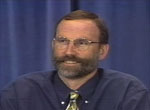 |
Dr. Phil Christensen
|
Camera system principal investigator Dr. Phil Christensen, Arizona
State University, Tempe, said, "We now have night vision on Mars
and have acquired images taken in complete darkness on the planet. The
daytime images help scientists map minerals and study safe places for
future Mars landings.
A new Mars image is posted daily by Christensen's team. To see the
images, go to http://themis.asu.edu/latest.html .
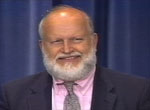 |
Dr. Bill Boynton
|
Dr. Bill Boynton, University of Arizona, Tucson, the gamma ray
spectrometer scientist and team leader, said, "We can see a
strong hydrogen signature in Mars' southern hemisphere, even without
boom deployment [scheduled for May]. There's a lot of water there."
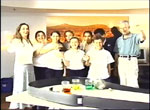 |
Dr. Bill Feldman (far right), Heather Enos (far left)
|
Neutron spectrometer scientist Dr. Bill Feldman, Los Alamos
National Laboratory, New Mexico, agreed and said, "We're finding
a lot of water ice in the soil of Mars."
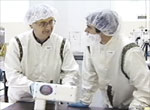 |
| Dr. Igor Mitrofanov |
Rounding out the gamma ray spectrometer team is Dr. Igor
Mitrofanov, principal investigator for the Russian high energy neutron detector.
He said, "A vast area of permafrost has been discovered
in the southern hemisphere and we start to see the northern
permafrost as well in high energy neutrons."
More information, including links, about the gamma ray
spectrometer suite of instruments is available at http://grs.lpl.arizona.edu/ .
The martian radiation instrument did not communicate for about
six months, but after extensive troubleshooting is now "talking"
with scientists again. The experiment measures radiation that could
endanger humans and provides a check on overall radiation that might
affect other Odyssey instruments.
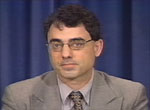 |
| Dr. Frank Cucinotta |
"This experiment is important for any future human exploration
of Mars," said principal investigator Dr. Frank Cucinotta, NASA
Johnson Space Center, Houston, Texas.
http://marie.jsc.nasa.gov/
has more information on the radiation instrument.
|